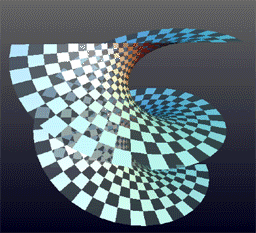Ranked voting system

In differential geometry, the associate family (or Bonnet family) of a minimal surface is a one-parameter family of minimal surfaces which share the same Weierstrass data. That is, if the surface has the representation
the family is described by
For θ = π/2 the surface is called the conjugate of the θ = 0 surface.[1]
The transformation can be viewed as locally rotating the principal curvature directions. The surface normals of a point with a fixed ζ remains unchanged as θ changes; the point itself moves along an ellipse.
Some examples of associate surface families are: the catenoid and helicoid family, the Schwarz P, Schwarz D and gyroid family, and the Scherk's first and second surface family. The Enneper surface is conjugate to itself: it is left invariant as θ changes.
Conjugate surfaces have the property that any straight line on a surface maps to a planar geodesic on its conjugate surface and vice-versa. If a patch of one surface is bounded by a straight line, then the conjugate patch is bounded by a planar symmetry line. This is useful for constructing minimal surfaces by going to the conjugate space: being bound by planes is equivalent to being bound by a polygon.[2]
There are counterparts to the associate families of minimal surfaces in higher-dimensional spaces and manifolds.[3]
References
43 year old Petroleum Engineer Harry from Deep River, usually spends time with hobbies and interests like renting movies, property developers in singapore new condominium and vehicle racing. Constantly enjoys going to destinations like Camino Real de Tierra Adentro.
- ↑ Matthias Weber, Classical Minimal Surfaces in Euclidean Space by Examples, in Global Theory of Minimal Surfaces: Proceedings of the Clay Mathematics Institute 2001 Summer School, Mathematical Sciences Research Institute, Berkeley, California, June 25–July 27, 2001. American Mathematical Soc., 2005 [1]
- ↑ Hermann Karcher, Konrad Polthier, "Construction of Triply Periodic Minimal Surfaces", Phil. Trans. R. Soc. Lond. A 16 September 1996 vol. 354 no. 1715 2077–2104 [2]
- ↑ J.-H. Eschenburg, The Associated Family, Matematica Contemporanea, Vol 31, 1–12 2006 [3]